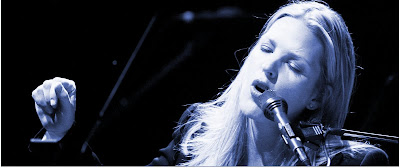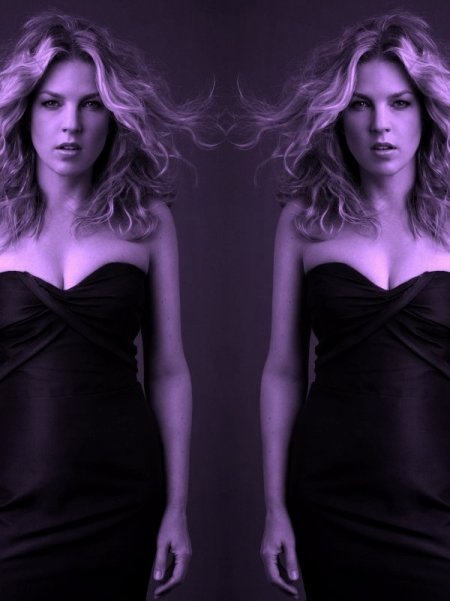By Juan Rodriguez, For Postmedia News June 26, 2011
 Diana Krall in many ways has polarized the jazz community. Critics argue her popularity is unwarranted. Fans adore her for sparkling piano and a sultry voice.
Diana Krall in many ways has polarized the jazz community. Critics argue her popularity is unwarranted. Fans adore her for sparkling piano and a sultry voice.
Photograph by: Dan Janisse, Postmedia News, For Postmedia News
_______________________________________________________________________________________
First, there are the numbers: Diana Krall has sold more than 15 million albums worldwide, including six million in the U.S., more albums than any other jazz singer of the 1990s and 2000s. She's the only singer to debut eight albums atop the jazz charts. Thus far, she has won three Grammy Awards and eight Junos, scoring nine gold, three platinum and seven multi-platinum albums.
Then, there are the tieins and associations: the ads for Lexus luxury autos, for Rolex watches, the countless magazine covers. In 2008, Nanaimo Harbourfront Plaza was renamed Diana Krall Plaza. Barbra Streisand asked her to produce her last album, in 2009. Clint Eastwood, a fan and a friend, featured her music in True Crime.
And, of course, there was the marriage to Elvis Costello at Elton John's estate.
Finally, there are Krall's looks: blond, sultry, in classic stylish wardrobe, the little black dress or the strapless gown, "glamorous and amorous," to paraphrase 'S Wonderful, the Gershwin song that opens her best-of album. You'd have to go back to Julie London to find a jazz ballad singer so aggressively marketed as a sex symbol. What's more, her success opened a lucrative market for retro stylists, inspiring a slew of other glamourpusses (like Norah Jones and Jane Monheit) to enter the fray, to various degrees of commercial success.
It's not supposed to be this way for a genuine jazz singer. Besides, how could a white woman from Nanaimo measure up to the legacies of Billie Holiday, Ella Fitzgerald, Sarah Vaughan and Dinah Washington, who overcame various forms of racial discrimination?
And how could she have the chutzpah of ostensibly imitating, in the form of a tribute album, the acknowledged master of the piano-guitarbass trio format, Nat King Cole, on her third album, All for You, breaking through to sell 100,000 copies within months?
"Has Diana Krall gone pop?" asked a Globe and Mail headline. Ergo, she's not a real jazz singer, right? Wrong.
Welcome to yet another jazz controversy over "purity" and preconceived notions.
Jazz is full of critic-generated brouhahas, which have, more often than not, dragged the music into a ghetto ruled by those "in the know."
Diana Krall is a polarizing figure who breaks conventional wisdom on what it means to be a serious jazz artist.
That sentiment was echoed by a self-described "aging jazz singer," who recently blogged: "I almost felt it was time for me to stop singing, because I saw so many younger singers with more beauty than talent making an impression.
Unfortunately, it's a fact of life that some people (many of them men) will buy albums because they can imagine a beauty singing to them. I'll never forget the spectacle of a friend's husband (who never much cared for vocalists) going gaga over a video of Diana Krall and playing it over and over again. It was pretty obvious that Krall's music was secondary."
Krall was criticized by Gary Giddens, the Village Voice's arbiter of jazz taste, for wrapping The Look of Love album in the airy satin-pillow-plush arrangements of Claus Ogerman, whose trademark lushness - which comes perilously close to sounding like Muzak - has graced albums by no lesser an artist than Antonio Carlos Jobim. (Then again, jazz critics have always had a thing against Ogerman, whom Giddens characterized as a "menace." I happen to love Ogerman's sound.)
In his intensely discriminating Biographical Guide to the Great Jazz and Pop Singers, Will Friedwald reiterates the three reactions to the huge success of Diana Krall over the last two decades:
"First, that she's really great, and deserves all the attention and acclaim that she's received. Second, that she's a total sham in a little black dress and high heels, foisted on the public by astute promoters, largely by virtue of her supermodel appearance. Third, that she's somewhere between the two poles - that she is, if not the greatest thing since sliced bread, certainly one of the more wonderful (and, correspondingly, more popular) performers of jazz and standards currently active, that she not only has a lot of talent, but works hard and is constantly improving her craft, and further, that her success bodes well for the future of this music. Speaking personally, I started with the second opinion, have been very comfortable with the third for a few years now, and am starting to veer toward the first."
Krall herself shrugs off the criticism, noting that, when she was a teenager, she adorned her bedroom wall with posters of Charlie Parker and Peter Frampton.
Such objections to the so-called corrupting influence of commerce (ugh) were not raised in the decade or so - the bigband era of the 1930s and '40s - when jazz really was America's popular music.
What the naysayers conveniently forget is that Ella, Sarah and Dinah all had big pop hits, and they all dressed glamorously. They all appeared on television regularly.
What's forgotten is that Krall started out as a pianist who had to be talked into singing by Jimmy Rowles, who, for years, was Fitzgerald's accompanist. She describes the piano as a guide to her vocals, a bold complement to a limited contralto.
She imbues the songs with subtle (yet adventurous) nuance - really, in the jazz tradition - rather than overt "trademark" mannerisms, the death trap for so many female singers these days.
She makes no attempt to "sound black" by adopting blues or gospel tinges.
Born Nov. 16, 1964, in Nanaimo, she was raised by musical parents; her mother sang in the community choir, her father played stride piano and was an avid collector of sheet music and old 78 r.p.m.s, and turned her on to Fats Waller.
Her other heroes included Nat King Cole, Teddy Wilson and Earl Hines, all of whom influenced her innate ability to establish rhythm (albeit her inimitable languorous rhythm).
Her preferred format - piano, guitar, bass - comes straight from Cole's famous trio of the '40s. (While most people remember Cole for his velvet voice, he was a groundbreaking, absolutely fearless and swinging pianist who conjoined the worlds of swing and bop.)
© Copyright (c) The Victoria Times Colonist
Fuente: www.timescolonist.com




1 comentario:
Thank you for your kind comment
Publicar un comentario